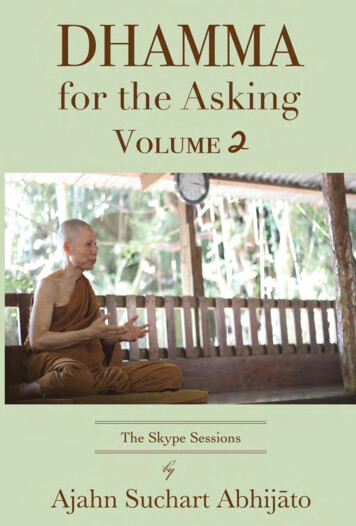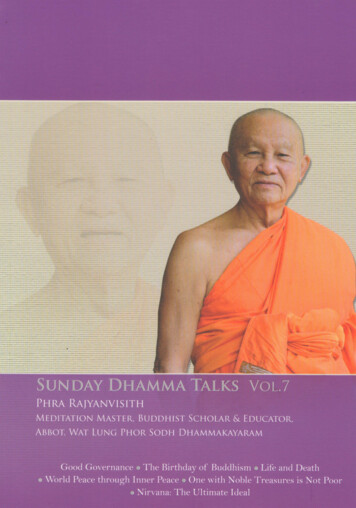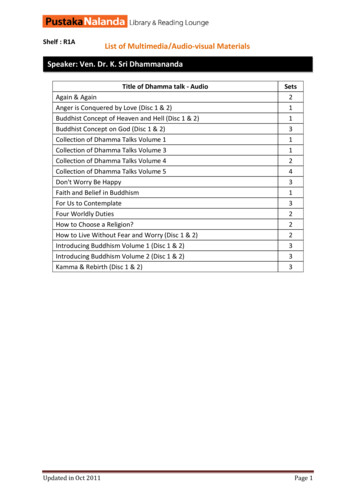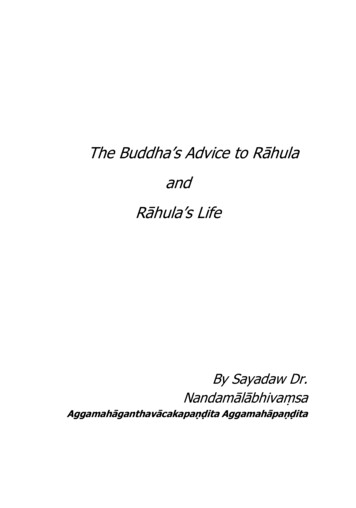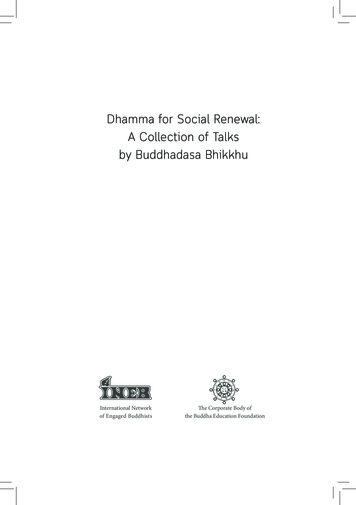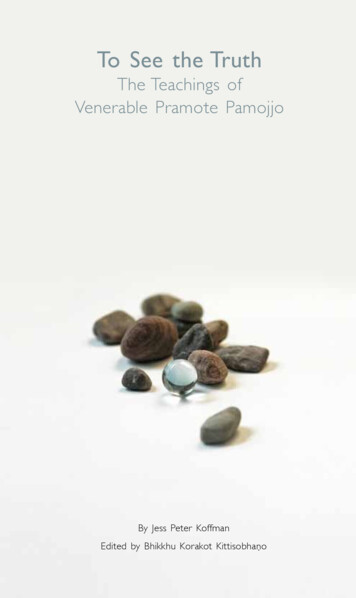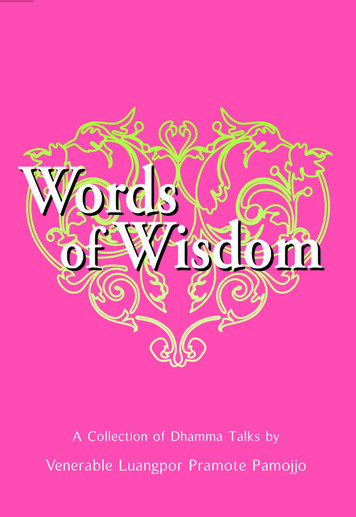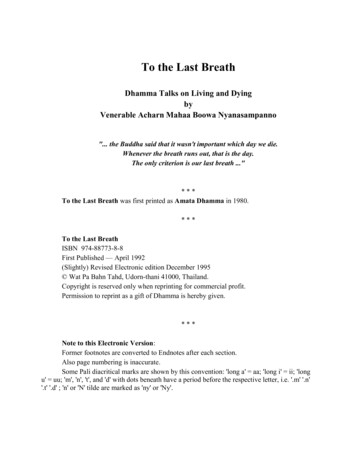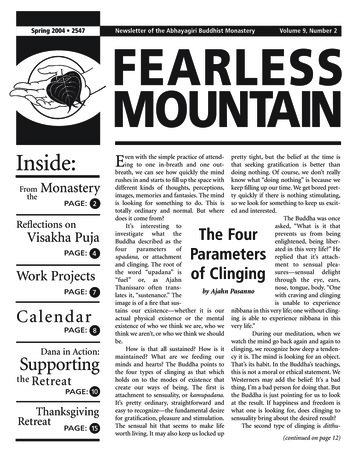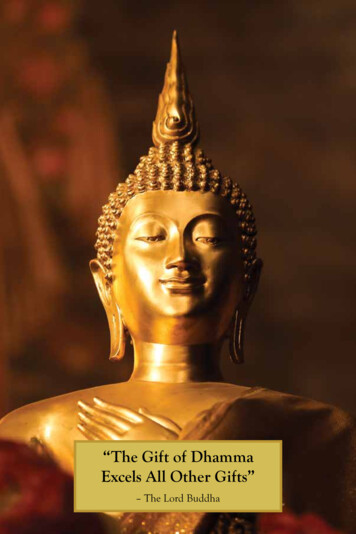
Transcription
TracesShort Dhamma talksby Ajahn Kalyāno
4
Namo Tassa Bhagavato Arahato SammāsambuddhassaNamo Tassa Bhagavato Arahato SammāsambuddhassaNamo Tassa Bhagavato Arahato SammāsambuddhassaBuddhaṃ Dhammaṃ Saṅghaṃ Namassāmi5
TracesPublished in 2021 by:Lokuttara VihāraLundsveien 196,1816, SkiptvetNorway.http://skiptvet.skogskloster.noThis book is offered for free distribution,please do not sell this book.Copyright Ajahn Kalyāno 2021Designer: Andy HackTypsnitt: Bodoni 72This work is licensed under the Creative CommonsAttribution-NonCommercial-NoDerivatives 4.0International License.To view a copy of this license, /4.0/See the end of this book for more detailson your rights and restrictions under this license.ISBN: 978-82-691347-1-1 (printed)ISBN: 978-82-691347-0-4 (pdf)6
Brand new dayBoots and lacesOut to playTracks and tracesOn the wayFacts and facesGoing to stayIn sacred places7
ContentBrand new day – Boots and laces. 9The Problem of SufferingTeacher and StudentSpiritual FriendshipFinding a Sense of UrgencySelf Criticism and Self LoveSkilful ThoughtMeditation for World Peace9111315161820Out to play – Tracks and traces. 21A Summary of Dhamma PracticeMindfulness of FeelingWorking Through our KarmaWhat is an Emotion?Buddhism and the Ecological CrisisArt and Poetry in Dhamma PracticeThe Euthanasia DebateAnger and Ill-willRight MindfulnessNatural Mindfulness21252933353941434547On the way – Facts and faces. . . 48Real MeritThe Doctrine of Anattā (not-self)Body WisdomThe Modern Mindfulness MovementPsychic PhenomenaThe Point of FocusKnowing in ActionA Radical Rewiring4849535455586061Going to stay – In sacred places. 66Finding Freedom in Right View66The Four Noble TruthsMindfulness of the BodyPositively EmptyTransformationAbout Ajahn KalyānoAcknowledgements8707375788184
Brand new dayBoots and lacesThe Problem of SufferingThe Buddha very plainly and straight-to-the-point saw suffering in itself as the primal problem that needed to be solved.He considered this problem very deeply, in its entirety, andfound that the solution was there in front of him already, inthe complete penetration of the problem itself – this gives usthe First Noble Truth, or the Noble Truth of Suffering.So what hope is there for us on the same path? It seems tome that very few people actually contemplate any problemfor very long before they start looking for a way to get awayfrom that problem, and even more so when it comes to theuncomfortable problem of suffering (however, this is surelyforgivable).How are we then to overcome this barrier? Perhaps bygritting our teeth and enduring it all until we somehow getthe message. Or perhaps we will need loads of therapy tocope with all the inevitable suffering of the world? Both ofthese methods are frequently taught, but they are not veryappealing, and they represent a fundamental misunderstanding as to the whole nature of this enquiry into suffering: theassumption that we are to investigate the feeling of sufferingrather than the perception ‘suffering’.But then, does this instead mean an intellectual exerciseto prove that everything is suffering?9
Not very appealing either; in fact downright depressing.This is a second common misunderstanding. Yet if suffering is simply seen with a very peaceful and meditative mind,we will let go and the experience will be not one of sorrowbut of blissful release. This is the way of the Buddha.10
Teacher and StudentStaring at the blank screen before writing can be nice, looking at the emptiness. Closing the document can be a relief.In the middle there can be a lot of uncertainty.Communication is not always easy. In Buddhist circles,however, I am not expected to take all the responsibility, andthis can make all the difference.In Buddhism some of this responsibility instead falls onthe listener; the relationship between teacher and student isnot a one-way relationship. It is the duty of the teacher topresent the teaching to the best of his ability, and the dutyof the student to tell the teacher if they think his or herteaching is straying from the Dhamma; it is then the duty ofthe teacher to listen to the feedback. It is further the duty ofthe student to find another teacher if things are not workingout. This can demand a lot of honesty, and for the studentanattitude of being prepared to move on and try to findthis newteacher. We might find that we have to put the Dhamma before attachments to individuals and places.For the teacher the challenge is often to stay with the truth rather than trying just to please the student, which is apotential pitfall, especially if his livelihood depends on therelationship. In this respect what protects the Dhamma isfor faithful Buddhists to support any monk or nun who iskeeping the discipline with his or her basic needs, regardless of their teaching. This generosity is based on the faiththat when the monks and nuns are training the way they do,they are developing an understanding of the inner life that isrelevant to all.11
This can be hard to fathom.“What relevance does all this have to life in the office?”I hear them say.“Listen with an open mind and decide for yourselves,” isthe reply. People from all walks of life have been doing sofor two and half thousand years and found sufficient value tosupport Monastics in return. Must be something in it, don’tyou think? After all, has human nature changed so much?12
Spiritual FriendshipThere is quite a contrast in direction between a spiritualfriendship and the more worldly kind of friendship.Just as a worldly mind is based on desire while a spiritualmind is based on wisdom and compassion – a worldly friendship is based on liking and disliking and a spiritual friendship on mindfulness. This means that our spiritual relationships can be of great value to us on the path. Sometimes, forinstance, we can see more clearly what is happening in anouter dynamic than we can in an inner one, and by thosemeans – by using the outer as a mirror for the inner – wecan ascertain whether we are headed in the right directionor not.Worldly friendship then is based on doing nice things together, on common tastes and preferences.And the habit of satisfying our worldly needs through eachothers company in turn leads to an attachment and dependence, which gives rise to more emotional needs – we lookfor reassurance that these desires will continue to be metin some way. Such a relationship can also begin to becomemore complex as our desires take the form of views regarding ourselves or the other person, which make us try to recast the friend into what we want him or her to be.Spiritual friendship has nothing to do with any of thesethings; in fact it goes in the opposite direction.A common view comes first, not last. A common vision of thespiritual path or goal is the beginning, the basis. This thenguides all the rest. The Buddha describes spiritual friendship as ‘association with the beautiful’.13
We can picture this as two practitioners bowing together atthe same shrine, or as each party respecting the spiritual aspirations of the other.So keeping a spiritual friendship together requires regularly checking where we both are on the path in relation tothe common vision. Making this vision take shape is then thesole purpose of the relationship. So the ultimate in terms of aspiritual friendship will be both to support each other in thestriving for enlightenment, and also supporting a monastery, or retreat centre in order to ensure that the material andpractical support for the spiritual life is there too.In this way worldly priorities are not omitted – doing sowould just amount to spiritual idealism, but they are put atthe end, they come after the spiritual affairs.We define what is needed in concrete terms to support thevision while we can also make practical compromises withoutcompromising that vision. We could perhaps combine spiritual discussions with baby-sitting, or something like that.14
Finding a Sense of UrgencyFor most people by far, the most prominent hindrance tospiritual practice – although not the most obvious one – isprocrastination. Meditation is so often the thing that can waituntil tomorrow. When did you last think, “I must just sit anddo nothing”? Sure, sometimes we are desperate for quiet orspace, yet the tendency is often to look for these outside ofourselves, which is of course easier – but less fruitful.Often spiritual practice is the last thing on our list becauseit is considered to merely be the cream on the cake or thecherry on top; or in other words, usually in turning to spirituality, we are seeking to put a spiritual gloss on our lives;but this is just spiritual materialism and it is simply barkingup the wrong tree, because all true spirituality has a renunciant flavour: It’s about letting go. Letting go of all the thingsthat don’t really matter.The traditional way to counteract this procrastinationand instead seek a sense of urgency is to contemplate death.However many people getting nervous about this topic tellme, very hurriedly, “There’s nothing you can do about that!”But in the light of our mortality we are drawn to re-examine our lives and see what really matters.15
Self Criticism and Self LoveMany Western practitioners ask me how to develop love forthemselves. Most of the people who ask are very good people. So why are they so self-critical? And why does simplybeing nice, kind or positive toward themselves not seem toreally help very much.Where did we get so screwed up, they will ask? Perhapsway back in the misty past?In the modern age, however, with wealth and technology,science and psychology, we have become so capable in somany ways that there is no end to the things we could do forourselves or for others. In my eyes, unless we can find somelimit to all this, we will always feel guilty for not doing enough. My solution to all this has been the Buddha’s contempltive teaching.Through true wisdom we can look at the greater, longerterm perspective and realise that we are not as able as wethought to control or change things. If we see this in theright way this can be very liberating.Drawing on a relevant example from modern sociologymany young men get depressed because they feel that theyare no longer needed. This is because women are now somuch more able to do without them with modern childcareand employment opportunity. The positive side of this, thatthe sociologists are trying to emphasise, is that men are alsomuch freer than previously to do their own thing. In this way,useless is good. We can live with gay abandon, can we not?But where is the love in it? In our ability to set others free inturn. If we find this freedom we realise that it leads to a different kind of love, a transformation of love into something16
that is deeply true and deeply freeing for all of us. We findwe can abandon, along with all the rest, the very self that wefound it so hard to love in the first place.17
Skilful ThoughtDiscussions of thought very often do not recognize the twosources from which it arises. One is the flow of automaticthought that operates just like the senses.We see something, for example, and an automatic flow ofthought (memory, imagination etc.) arises as a result in themind. Then there is the thought that we add consciously tothat automatic flow in the present.When our thought in the present is wholesome it takesthe automatic flow in a good direction, towards happiness. When it is unwholesome it takes it in a bad direction,towards unhappiness.When the automatic flow is silent or empty then we have anempty canvas to paint on. Meditation practice helps us tosee this process clearly and act appropriately. We do not getmixed up and see these two sources of thought as the same.We don’t blindly believe or join in with the automatic; at thesame time we see the importance of it, that if we are not careful it can make us suffer.We clearly see what is wholesome or unwholesome inour present experience, as defined by its result in happinessor unhappiness. We see the influence of present-momentthought, good or bad, on our own mind machine.Ultimately we see the potential to replace automatic withpresent moment thought and take control of the mind.When we continue to take it in a wholesome direction wesee the happiness that results. The present moment thoughtbecomes more and more dominant until it takes over.18
In contrast we see that we can never control the mind thatgoes in the unwholesome direction, we see that it takes ona life of its own.19
Meditation for World PeaceWhen we meditate we can be doing so to look for inner peace, or we can have a grander vision and purpose – we can bepractising for world peace or happiness.Actually if we can clearly see the connection between these two ways of practice, they may not be so different after all.The difference may be not what we are doing in our practicebut in our attitude. Do we have an attitude of sharing? Dowe have faith that our state of mind can have a wider influence on the world or not? Even if we cannot see this influencewhile we are meditating, we can find ourselves kinder afterwards. Then we can see that peace in the world can beginwith peace in our own hearts.Indeed we don’t have to have problems in order to meditate, we can do so for these higher reasons. We can be findinga peaceful place, a safe refuge in ourselves, by meditating orby coming to the monastery, and we can then be sharing thispeace with the world.Some people wonder why monks and nuns are not involved in politics. Maybe there is more than one way to changethe world.20
Out to playTracks and tracesA Summary of Dhamma PracticeThe ability to tolerate painful feeling opens up a new dimension to experience. If we can develop this power, our mindsare no longer obsessed with avoiding these feelings. In thisway we let go of our desires for the sake of following moralprecepts or a discipline, this is virtue (sīla). We let go of ourdesires in order to follow the breath instead, this is meditation. We practise contemplating the suffering of mind andbody to let go of desire once and for all, this is wisdom.It is only if we cannot see anything other than conditionedreality that the Buddha’s teachings on suffering can seem anegation of everything.Ultimately, all our suffering arises from such a limitedview. Dhamma offers a different view of what is real and possible; by merely accepting this potential we will be happier,if we can realise it much happier still.The end of suffering is to see things completely the waythey are, and to completely accept that truth.21
The MindAs we start to look inside we realise that what remains whenwe close our eyes to meditate are precisely those things thatwe get attached to when they are open. If we can avoid blindly reacting to such emotions it is good, but not to respondto emotion at all is not good. If we look for a resolution toa painful memory simply by watching together with attempting to avoid adding new negative karma to it, then we willnot have lastingly gotten over anything, even if it might seemso at that time.Every time the emotions connected to that memory arisethe pain will keep arising, until we add something positive orchange our view of what happened.The best way to operate is to allow things to come up ontheir own, to come to us if possible and then, when they havearisen, look for a wholesome and skilful response.Taking it further, the practice is aimed not merely at resolving specifics or making peace with ourselves, but to reallyget to the heart of things. When we can do this – and thecalmer and emptier heart acts like a mirror to the mind – wesee that emotions arise based on perceptions. And we havedifferent sets of emotions based on different perceptionsthat we have had over time, often related to different intentions or roles.And these emotions give rise to different personae. Thisis natural, it is only if we have fixed ideas about our feelingsthat we become confused and experience inner conflict.This ‘fixing’ is like touching ourselves with our minds,and it reinforces and attaches us to emotions, making themappear more real, just like touching the physical world makes it real in our minds. But if we don’t touch we can instead22
re-examine the validity of our perceptions. Yet we also haveto recognize and tackle what it is that makes us want to‘touch ourselves’.How does the craving for and attachment to such feelingarise?23
The BodyWe have to trust the teaching that the source of attachment– i.e. feeling – is different from the source of detachment– the clear seeing of the body. This fact makes the deepestpractice indirect; we undermine our attachment to the bodyin order to uproot our attachment to feeling. While we arewalking this path we might discover the pleasant feeling ofspace or of letting go whereby we overcome the need for thepleasant feelings of holding on. This is our stepping stone toletting go of feeling altogether.Then the only way to prevent the needs of the body ormind to pull us out of these pleasant spaces in our minds andhearts is to draw those spaces right into the body. Relaxingthe body is the first step; being relaxed about the body is thesecond. Yet the ultimate purpose here is to completely let goof the body, at the right time, in the right and peaceful way,for the right reason.This will take us to the Deathless.If we see that the mind in its worldly conditions is dependent on the body, but in essence is not the body; then wecan see the possibility of a mind that is not dependent on aparticular body but just any body – hence the possibility ofrebirth. We can let go moment by moment and of one bodyfor another.And if this mind-essence or spirit becomes stable we seethe possibility for it to detach completely from all bodies –or from physicality in itself. We will also see that while welive out our lives, the detached position is the mind contained within the body, neither in the world nor away from it,and that such detachment is gained by seeing suffering withcompassion. Seeing suffering the mind lets go, but havingcompassion it does not withdraw.24
Mindfulness of FeelingLet us consider the role of mindfulness and meditation inour active daily life. It is the nature of the mind that it canonly be on one thing at a time. It is also the nature of themind to wander from one thing to another. So to developmindfulness, most of us need to simply develop the skill ofkeeping our minds from wandering, hence the meditationpractice.Mindfulness also requires a clear conscience, a sense ofacceptance and commitment to what we are doing and alsoclear decision-making, yes or no, so that the mind is not fullof regret or continually wavering and doubting.There will then be times when the mind gets tired andneeds a break, again we can use the meditation to let go ofour task and rest the mind, and if that is not enough we canmore actively withdraw in some way.Becoming aware of the body and relaxing is a good way –relax the body and the mind will follow.One way in which we lose our mindfulness, perhaps themain way, is that our feelings about something draw us awayfrom our task or situation.Often these days we are then given the advice to be awareof our feelings, but this divides our attention.But if we instead ignore our feelings, then we can also gowrong since they may represent valid feedback – the solution is to acknowledge the feeling and check to see if this isthe case. If we feel averse to something we can ask ourselveswhat exactly we are averse to, and similarly when we are attracted to something.25
In this way we regain our attention to search for the source ofthe feelings and find some perspective.A neutral perspective is what leaves our minds calm andbest supports our mindfulness. If we find it difficult to find anew perspective for ourselves we can talk to someone else,preferably a neutral person, to help find clarity.It is considered healthy these days to get out of “beingstuck in our heads” and instead feel our feelings. The qualityof this attention to feelings, however, is also important. Anxious attention will make anxious feelings worse, for example.So there is a need to calm the mind or find someone else witha calmer mind to help us before we go to such feelings. Weneed to recognise that it can be hard to stay calm and cleararound negative feelings, or that we can get hooked on pleasant ones that are not taking us in a good direction.A calm mind is one that is sensitive as well as one that isnot easily overwhelmed.Many of our feelings constitute an alarm ringing in response to an event – whether real, remembered or imagined.Going to a feeling with a calm mind, a calm touch, can belike resetting the alarm. This is skilful once we are confidentthat we have noted the danger or realised that there is no realdanger. But to reset the alarm in the face of danger is justheedless.There is also a tendency to get drawn into feelings to thepoint where we lose track of what they are really about, wefocus down on them, fishing for meaning, when it is by thisvery act of focus that we lose our awareness of the context inwhich they are arising. All feelings are perfectly clear whenwe can step back and see the whole picture. When we saythat we are not sure how we feel about something, this does26
not actually mean that the feelings are not clear, but that ourperceptions as they shift around on something, our feelingschange.A good question to ask is “how am I seeing things thatmake me feel like this?” Getting to the perception behindthe feeling will always clarify. Often too, we are not sure whatwe want in a situation, but if we can get to a clear perceptionwe will know the answer.It is interesting how we think and speak in terms of feelings, when what we are really talking about is perceptionsand desires. Perhaps we are not being very up front even toourselves, and this gives so much power to feelings – howcan they be questioned when we constantly let them operatein the dark? And it’s not at all the case that giving them suchpower makes them any more pleasant.So, stepping back from and opening up around feelingsto gain the full picture can be the key. This can also help usdiscover bigger feelings. In my mind, when it comes to feelings, the bigger the better. So it is in the spiritual life, weare prioritising bigger and more lasting feelings, and we arecareful not to sacrifice these for short term gratification. Wealso recognise that spiritual feelings associated with lettinggo are more pleasant than sensual feelings.When our minds are very clear and quick, it can be possible to note pleasant and unpleasant perceptions of thingswithout the arising of feelings of attraction or aversion in thefirst place. Actually we can protect ourselves from feelings ofsuffering with the perception ‘suffering’.So much for the more transitory and particular feelings,what about the underlying stress of life? Let us take fearas an example of acute stress. By momentarily placing our27
awareness on the feeling rather than running from it, we cansteady ourselves and look for a course of action. If the courseof action is clear but we are still afraid, then the solution isto reflect. We can ask ourselves what we are afraid of, in thatway taking our minds back to the task or situation, lookingfor a change of perception; and if we find a new one, we canfeel out the change, relaxing into the new perception.In a deeper sense and in the long-term, fear has its rootsin anxiety as to our physical safety. This is very often misplaced, arising through a wrong perception, but none the lessvery hard to shake as the perceptions involved are preconscious and very deep-rooted.The feelings as well have always been around.The meditator can discover that the ultimate solution tofear and stress is to let go of our attachment to the body. Thisis protecting our minds from the arising of stress by establishing a different perception. This comes through deepermeditation practice and reflection, it comes gradually and isnot an all or nothing thing to begin with. If we manage tolet go a little bit we will be a bit less serious about life. If wemanage to let go of the body completely (this may also betransitory or permanently) instead of stress, our minds willbe full of joy and a sense of liberation.28
Working Through our KarmaResolving past karma.The Buddha’s teaching on karma often gets associated withthe teachings on rebirth and are therefore somewhat neglected in the Western world where we do not believe in suchthings. This is the case despite the fact that many peoplecome to the teachings looking to resolve suffering rooted inthe past. The Buddhist understanding of how to do this isvery simple however and actually does not require a belief inrebirth. People can act to resolve bad karma, the dark eventsof the past, whatever their cause, by making good karma inthe present.This is not blaming ourselves for whatever bad things thathappened in the past, it is not to dwell on the past at all, butto see and concentrate on the potential for positive actionin the present. The ability to do this is one of the benefitsof strong mindfulness, of a mind strongly rooted in the present. This swings the overall balance of the mind, or of thesituation we are in, from unhappy to happy. I have developeda lot of faith in this.I notice how if my mood is happy overall then issues fromthe past or painful memories are not a problem, they arerather a source of motivation to strive on.I saw this very strongly when my father was made redundant at work and to everyone’s complete surprise and dismay committed suicide. What really helped me was not todwell on the past (or to blame his heartless bosses) but tothrow myself into what I could do to help the situation in thepresent – initially this was drawn out of me by looking aftermy mother and brother who had found his body and were in29
deep shock. Then looking after everyone, including myself,through all the grief.30
Keeping in creditI also notice in the present how inescapable karma is.If someone does something for me and I do not repay thatin some way then I feel uncomfortable, there is a sense ofbeing in debt. This seems to apply in general as well, feelingin debt to the world rather than in credit is an unhappy state.In contrast being in credit with the world is a joyful feeling– this is what makes generous people so genuinely, lastinglyhappy.Let me poke fun at the modern consumer attitude for amoment, by way of contrast – surviving at the most voluntaryend of the voluntary sector as I am, where there is no moneyinvolved at all – if I read between the lines am I not hearingthe unhappy ones saying: “I am too busy to do anything foryou but I’m not too busy for you to do something for me.And above all else, I am always too busy to do anything Idon’t like.” “Hmm no wonder you’re unhappy”, I thinkto myself.We can draw a parallel between the resolution of past karma, that we have already considered, and the management ofkarma in the present. Here too it is not a matter of needingto resolve a particular situation, to repay a particular person.Although this might always be appropriate it is not alwayspossible. If for example a doctor gives us a life-saving operation, we cannot give him or her an operation in return. Thatwould be silly.What we can do is to be grateful, and then in turn this willmotivate us to do things for others, for the world, in return.If we are mindful enough, what remains in the centre of ourattention is the goodness (or otherwise) of our actions ofbody, speech or mind. Then we will be clearing our minds31
of karma as we go (like the windscreen-wipers of a car clear the screen to keep our vision clear as we go along) andentering fully into the present. This is the very best we cando, our highest potential within the world of karma. Yet it isalso here in the present that we can naturally experience theinsight into the nature of the world that is the escape fromkarma altogether. The key to this is to see our common humanity through the development of mindfulness of the body.32
What is an Emotion?In Buddhism we see all emotional suffering as constitutingsome kind of lack of response from the mind. This is differentfrom understanding our suffering to be a question of merelybeing exposed to our own negativity or that of other’s negativity. Instead it is recognising suffering as an expressionof need, and seeing the potential of the mind and heart tosatisfy those needs and thereby resolve the whole situation.Our initial lack of response can be originated in our owninability to hear the underlying needs. Secondly, our ability to respond to these needs is hampered by our reactions,through the dominance of habit. The stirred up emotionscan be so intense that we end up lost in them, responding tothem rather than to their causes.But in the spiritual training we can begin to calm thesereactions, to calm our minds in the face of them and stepback from them. And so we can see them for what they are –a kind of automatic pilot. And then through mindfulness wetake the joystick in life, so to speak, and steer ourselves in abetter way.Then our training of the mind can go in different directions – we can meditate, or contemplate, or even both:Regarding meditation we can strengthen our mindfulnessfurther and add positive qualities to our attention in the present, patience and kindness, for example. Such qualities canbecome universally wholesome spontaneous responses, toall life situations.As for contemplation, our calmer mind gives us the space we need to question our perceptions of life, to find moreskilful alternatives that are both completely benevolent and33
also in line with reality or the truth, and that acknowl
Short Dhamma talks by Ajahn Kalyāno races T. 4 5. 4 5 . A Summary of Dhamma Practice 21 Mindfulness of Feeling 25 Working Through our Karma 29 What is an Emotion? 33 Buddhism and the Ecological Crisis 35 Art and Poetry in
